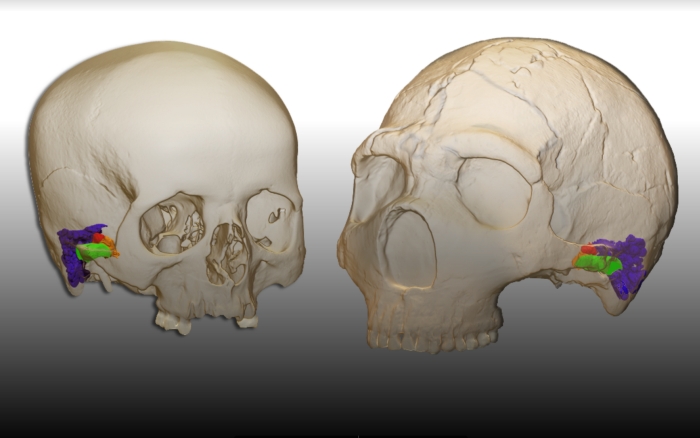A major discovery shows Neanderthals could speak human language
- November 25, 2023
- 0
A study published in 2021 showed that our Neanderthal cousins had the ability to both hear and reproduce the speech sounds of modern humans. The study, based on
A study published in 2021 showed that our Neanderthal cousins had the ability to both hear and reproduce the speech sounds of modern humans. The study, based on

A study published in 2021 showed that our Neanderthal cousins had the ability to both hear and reproduce the speech sounds of modern humans. The study, based on a detailed analysis and digital reconstruction of the bone structure in the skulls, resolved one aspect of the decades-long debate over the language abilities of Neanderthals.
“This is one of the most important studies I have been involved in in my career,” Binghamton University paleoanthropologist Rolf Quam said in 2021.
“The results are intriguing and clearly show that Neanderthals were capable of perceiving and producing human language. This is one of the few existing studies that rely on fossil evidence to study the evolution of language, which is known to be a rather difficult subject in anthropology.”
Neanderthals (homo neanderthal) were much more primitive than modern humans (homo sapiens), has become obsolete, and in recent years there has been a growing body of evidence to suggest that they are much more intelligent than we once assumed. They developed technology, created tools, created art, and held funerals for their dead.
However, whether they communicate with each other remains a mystery. Their complex behavior seems to indicate that they must have been able to communicate, but some scientists argue that only modern humans have the mental capacity for complex language processes. It will be very difficult to prove whether this is the case, but the first step will be to determine whether Neanderthals were able to produce sounds in the optimal range for language communication.

A team led by paleoanthropologist Mercedes Conde-Valverde from the University of Alcalá in Spain decided to do this using really old bones.
They took high-resolution CT scans of the skulls of five Neanderthals to create virtual 3D models of their ear structures. They also modeled the structure of the ear homo sapiens and a much older fossil, the skull of the Sima de los Huesos hominin, also known as the Sima hominin, an ancestor of Neanderthals, dating to about 430,000 years ago.
A model of the auditory capacity of these structures from the field of auditory bioengineering was then used to understand the frequency range to which ears are most sensitive, also known as occupied bandwidth. The frequency band occupied for modern humans is the human voice range.
The team found that Neanderthals heard better than Sim’s ancestors in the 4 to 5 kilohertz range, and that the frequency range occupied by Neanderthals was closer to modern humans than Sim’s hominin. This optimization strongly suggests that Neanderthals needed to hear each other’s voices.

“That’s really the key,” Conde-Valverde said.
“The presence of similar hearing abilities, especially bandwidth, suggests that Neanderthals had a communication system as complex and effective as modern human language.”
Interestingly, the frequency band occupied by Neanderthals extended to frequencies above 3 kilohertz, which were mainly involved in the production of consonants. This would distinguish Neanderthal sounds from those based on vocal primates and other mammals, the team noted.
“Most previous studies on the language abilities of Neanderthals have focused on their ability to produce basic vowels in spoken English,” Quam said.
“However, we believe this emphasis is misplaced, as the use of consonants is a way of adding more information to the sound signal, distinguishing human speech and language from the communication patterns of almost all other primates. The fact that our study addresses this is a really interesting aspect of the study and provides insight into the language abilities of our fossil ancestors.” “A new suggestion.”
Researchers warn that having an anatomy capable of producing and hearing speech does not necessarily mean that Neanderthals had the cognitive abilities to do so. But they note that we have no evidence that Sima hominids exhibited the complex symbolic behavior such as funerary rituals and artwork that we find associated with Neanderthals.
This difference in behavior is similar to the difference in hearing ability between Neanderthals and Simian hominids; This suggests that complex behaviors and the ability to communicate vocally evolved together, the researchers say.
They write in their paper: “Our results, together with recent discoveries showing the symbolic behavior of Neanderthals, support the idea that they had a human language that was very different in complexity and efficiency from other verbal system communications used by non-human organisms on the planet.”
Source: Port Altele
As an experienced journalist and author, Mary has been reporting on the latest news and trends for over 5 years. With a passion for uncovering the stories behind the headlines, Mary has earned a reputation as a trusted voice in the world of journalism. Her writing style is insightful, engaging and thought-provoking, as she takes a deep dive into the most pressing issues of our time.